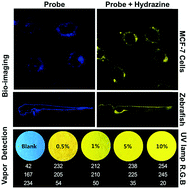Ratiometric fluorescence probe for hydrazine vapor detection and biological imaging†
Abstract
Hydrazine (N2H4) has been widely applied in most of the chemical industry; however, it is now believed that it can cause serious damage to protein and nucleic acid upon ingestion. Herein we introduced a specially designed molecular probe 1, with an electron deficient lactone group as a specially designed reactive site and a naphthalimide fluorophore that is easily modified owing to lactone involvement. The free probe 1 exhibited blue fluorescence in neutral buffer owing to the low favorability of ICT (intramolecular charge transfer), while the specially designed lactone group could potentially undergo a ring-opening reaction with hydrazine, resulting in a favoured ICT effect and bathochromically shifted (125 nm) fluorescence response. The ratiometric fluorescence signal enabled quantitative determination of hydrazine using probe 1 in complex applications. Besides, probe 1 features a rapid signal response time (within 5 min) and low detection limit (36 nM) for hydrazine. Utilizing these excellent properties, probe 1 was further applied in hydrazine vapor detection and bio-imaging. Conceptually, we now present a new approach for the detection of hydrazine, and the enhanced performances of probe 1 will promote its applications in living systems and the environment.



 Please wait while we load your content...
Please wait while we load your content...